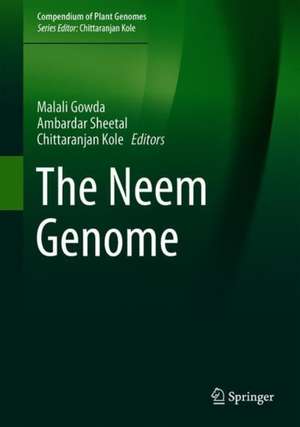The Neem Genome: Compendium of Plant Genomes
Editat de Malali Gowda, Ambardar Sheetal, Chittaranjan Koleen Limba Engleză Hardback – 4 noi 2019
This book describes the sequencing efforts for Neem (Azadirachta indica A. Juss), one of the most versatile tropical evergreen tree species. The neem tree is a source of various natural products, including the potent biopesticide azadirachtin and limonoids, which have a broad spectrum of activity against insect pests and microbial pathogens. To identify genes and pathways in neem, three neem genomes and several transcriptomes are studied using next-generation sequencing technologies.
Neem has been extensively used in Ayurveda, Unani and homoeopathic medicine and is often referred to as the ‘village pharmacy’ by natives due to its wealth of medicinal properties.
Besides the description of the genome, this book discusses the neem microbiome and its role in the production of neem metabolites like salanin, nimbin and exopy-azadirachtin under in vitro conditions. It also highlights cell and tissue culture using various neem explants including the leaf, root, shoot, cambium, etc.
| Toate formatele și edițiile | Preț | Express |
|---|---|---|
| Paperback (1) | 939.14 lei 6-8 săpt. | |
| Springer International Publishing – 4 noi 2020 | 939.14 lei 6-8 săpt. | |
| Hardback (1) | 946.41 lei 6-8 săpt. | |
| Springer International Publishing – 4 noi 2019 | 946.41 lei 6-8 săpt. |
Din seria Compendium of Plant Genomes
- 24%
 Preț: 783.67 lei
Preț: 783.67 lei - 18%
 Preț: 948.92 lei
Preț: 948.92 lei - 15%
 Preț: 643.34 lei
Preț: 643.34 lei - 15%
 Preț: 643.84 lei
Preț: 643.84 lei - 18%
 Preț: 950.21 lei
Preț: 950.21 lei - 18%
 Preț: 956.18 lei
Preț: 956.18 lei - 18%
 Preț: 1398.00 lei
Preț: 1398.00 lei - 18%
 Preț: 1396.89 lei
Preț: 1396.89 lei - 15%
 Preț: 645.28 lei
Preț: 645.28 lei - 18%
 Preț: 1119.74 lei
Preț: 1119.74 lei - 18%
 Preț: 947.98 lei
Preț: 947.98 lei - 18%
 Preț: 954.93 lei
Preț: 954.93 lei - 18%
 Preț: 957.44 lei
Preț: 957.44 lei - 18%
 Preț: 1114.97 lei
Preț: 1114.97 lei - 18%
 Preț: 956.69 lei
Preț: 956.69 lei - 18%
 Preț: 951.91 lei
Preț: 951.91 lei - 18%
 Preț: 952.89 lei
Preț: 952.89 lei - 18%
 Preț: 952.57 lei
Preț: 952.57 lei - 18%
 Preț: 953.97 lei
Preț: 953.97 lei - 18%
 Preț: 950.33 lei
Preț: 950.33 lei - 18%
 Preț: 1228.96 lei
Preț: 1228.96 lei - 18%
 Preț: 951.77 lei
Preț: 951.77 lei - 18%
 Preț: 955.56 lei
Preț: 955.56 lei - 15%
 Preț: 643.48 lei
Preț: 643.48 lei - 15%
 Preț: 646.30 lei
Preț: 646.30 lei - 18%
 Preț: 1113.26 lei
Preț: 1113.26 lei - 15%
 Preț: 643.65 lei
Preț: 643.65 lei - 15%
 Preț: 633.53 lei
Preț: 633.53 lei - 18%
 Preț: 956.03 lei
Preț: 956.03 lei - 18%
 Preț: 951.59 lei
Preț: 951.59 lei - 18%
 Preț: 1119.56 lei
Preț: 1119.56 lei - 18%
 Preț: 1115.46 lei
Preț: 1115.46 lei - 18%
 Preț: 950.33 lei
Preț: 950.33 lei - 18%
 Preț: 955.56 lei
Preț: 955.56 lei - 18%
 Preț: 951.77 lei
Preț: 951.77 lei - 18%
 Preț: 947.98 lei
Preț: 947.98 lei - 18%
 Preț: 1669.96 lei
Preț: 1669.96 lei - 18%
 Preț: 1123.98 lei
Preț: 1123.98 lei - 18%
 Preț: 1114.52 lei
Preț: 1114.52 lei - 18%
 Preț: 954.62 lei
Preț: 954.62 lei
Preț: 946.41 lei
Preț vechi: 1154.16 lei
-18% Nou
Puncte Express: 1420
Preț estimativ în valută:
181.12€ • 188.39$ • 149.52£
181.12€ • 188.39$ • 149.52£
Carte tipărită la comandă
Livrare economică 15-29 aprilie
Preluare comenzi: 021 569.72.76
Specificații
ISBN-13: 9783030161217
ISBN-10: 3030161218
Pagini: 143
Ilustrații: XVIII, 123 p.
Dimensiuni: 178 x 254 mm
Greutate: 0.47 kg
Ediția:1st ed. 2019
Editura: Springer International Publishing
Colecția Springer
Seria Compendium of Plant Genomes
Locul publicării:Cham, Switzerland
ISBN-10: 3030161218
Pagini: 143
Ilustrații: XVIII, 123 p.
Dimensiuni: 178 x 254 mm
Greutate: 0.47 kg
Ediția:1st ed. 2019
Editura: Springer International Publishing
Colecția Springer
Seria Compendium of Plant Genomes
Locul publicării:Cham, Switzerland
Cuprins
Economic/Academic importance.- Botanical descriptions and distribution.- Traditional practices and knowledge of neem.- Biochemistry, medicinal properties and molecular biology of neem bioactives.- Quantification of secondary metabolites of neem.- Utilization of neem and neem products in agriculture.- Requirement of whole-genome sequencing.- Strategies & tools for sequencing.- Genome Assembly.- Repetitive sequences.- Gene annotation.- Synteny with allied & model genomes.- Comparison of gene families.- Impact on neem tree improvement breeding.- Neem tissue culture.- Neem microbiome.- Future prospects.
Notă biografică
Textul de pe ultima copertă
This book describes the sequencing efforts for Neem (Azadirachta indica A. Juss), one of the most versatile tropical evergreen tree species. The neem tree is a source of various natural products, including the potent biopesticide azadirachtin and limonoids, which have a broad spectrum of activity against insect pests and microbial pathogens. To identify genes and pathways in neem, three neem genomes and several transcriptomes are studied using next-generation sequencing technologies.
Neem has been extensively used in Ayurveda, Unani and homoeopathic medicine and is often referred to as the ‘village pharmacy’ by natives due to its wealth of medicinal properties.
Besides the description of the genome, this book discusses the neem microbiome and its role in the production of neem metabolites like salanin, nimbin and exopy-azadirachtin under in vitro conditions. It also highlights cell and tissue culture using various neem explants including the leaf, root, shoot, cambium, etc.
Caracteristici
Details the botany of neem, an ancient medicinal plant, the traditional use of neem in herbal medicine, and the use of neem products in agriculture Discusses the biochemistry, medicinal properties, and molecular biology of bioactives in neem Addresses draft genome sequencing, genome assembly, gene annotation, synteny with allied genomes and comparison of gene families Elaborates on tissue culture research on neem and the impact of genome sequencing on neem breeding
